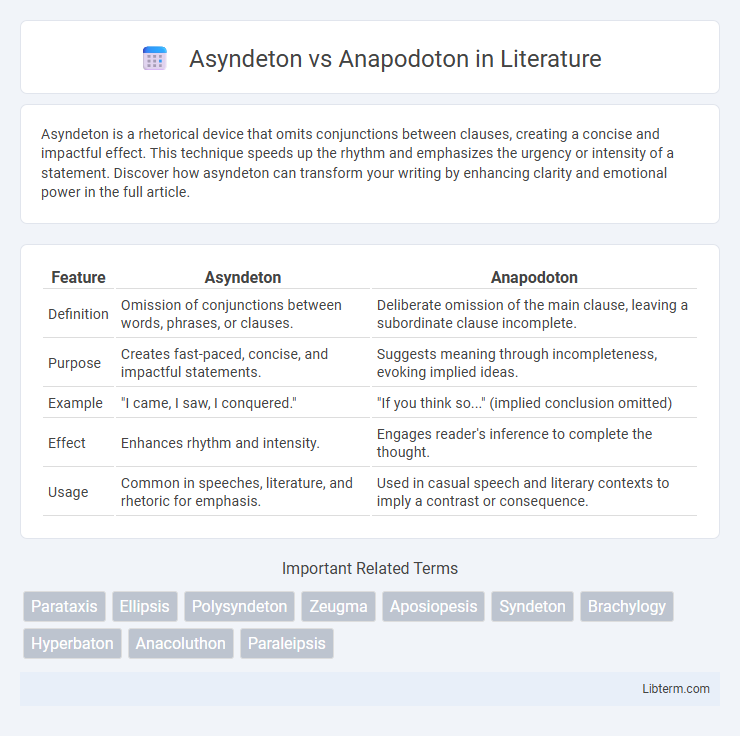Asyndeton is a rhetorical device that omits conjunctions between clauses, creating a concise and impactful effect. This technique speeds up the rhythm and emphasizes the urgency or intensity of a statement. Discover how asyndeton can transform your writing by enhancing clarity and emotional power in the full article.
Table of Comparison
| Feature | Asyndeton | Anapodoton |
|---|---|---|
| Definition | Omission of conjunctions between words, phrases, or clauses. | Deliberate omission of the main clause, leaving a subordinate clause incomplete. |
| Purpose | Creates fast-paced, concise, and impactful statements. | Suggests meaning through incompleteness, evoking implied ideas. |
| Example | "I came, I saw, I conquered." | "If you think so..." (implied conclusion omitted) |
| Effect | Enhances rhythm and intensity. | Engages reader's inference to complete the thought. |
| Usage | Common in speeches, literature, and rhetoric for emphasis. | Used in casual speech and literary contexts to imply a contrast or consequence. |
Understanding Asyndeton: Definition and Examples
Asyndeton is a rhetorical device characterized by the deliberate omission of conjunctions between words, phrases, or clauses, creating a fast-paced, impactful, and concise expression. Common examples include Julius Caesar's "I came, I saw, I conquered," where the absence of "and" intensifies the statement's urgency and rhythm. Understanding asyndeton helps writers and speakers emphasize key ideas, enhance dramatic effect, and maintain audience engagement through streamlined syntax.
Anapodoton Explained: Meaning and Usage
Anapodoton is a rhetorical device where a main clause is deliberately left incomplete, implying meaning through an omitted or unstated conclusion, often seen in everyday speech and literature. This figure of speech creates a sense of immediacy or tension by relying on the audience's ability to infer the missing part, enhancing engagement and emphasis. Anapodoton contrasts with asyndeton, which involves the omission of conjunctions between clauses rather than the omission of the main clause itself.
Key Differences Between Asyndeton and Anapodoton
Asyndeton is a rhetorical device that omits conjunctions between words, phrases, or clauses to create a concise and impactful statement, such as "I came, I saw, I conquered." Anapodoton, on the other hand, involves the deliberate omission of the main clause or completion of a sentence, leaving an implied meaning, often found in expressions like "If only..." or "When in Rome...". The key difference lies in asyndeton's focus on removing conjunctions for rhythm and speed, while anapodoton relies on incomplete sentence structures to evoke implied or conditional meanings.
Historical Origins of Asyndeton and Anapodoton
Asyndeton traces back to ancient Greek and Latin rhetoric, where classical authors like Homer and Cicero employed the technique to create rapid, impactful expressions by omitting conjunctions. Anapodoton, rooted in classical Greek literature, involves leaving a clause incomplete, relying on audience inference, and was commonly used in proverbs and dramatic speech. Both figures of speech evolved from early rhetorical traditions aimed at enhancing oral persuasion and stylistic emphasis in classical oratory and poetry.
Rhetorical Impact: Why Writers Use Asyndeton
Asyndeton enhances rhetorical impact by creating a rapid, concise rhythm that emphasizes key ideas and intensifies emotional resonance. Writers use asyndeton to generate suspense and urgency, often making lists or phrases more memorable and impactful by omitting conjunctions. In contrast, anapodoton relies on implied meaning through incomplete sentences, which can create dramatic pauses but lacks the immediate force and fluidity provided by asyndeton.
The Subtlety of Anapodoton in Modern Writing
Anapodoton subtly enhances modern writing by intentionally omitting the second half of a sentence, creating an implied meaning that engages readers' inference skills more deeply than straightforward asyndeton does. This rhetorical device leverages the power of suggestion, often provoking curiosity and emphasizing the unsaid, which adds a layer of sophistication to contemporary prose and dialogue. Its nuanced use contrasts with asyndeton's direct omission of conjunctions, positioning anapodoton as a tool for psychological and interpretive depth in narrative and persuasive contexts.
Grammatical Structures: Asyndeton vs Anapodoton
Asyndeton involves the deliberate omission of conjunctions between a series of related clauses or phrases, creating a concise and impactful grammatical structure. Anapodoton, by contrast, features an incomplete sentence or phrase where the main clause is implied but not explicitly stated, relying on contextual understanding for completion. Both structures manipulate standard grammar rules to enhance rhetorical effect, with asyndeton emphasizing rapid progression and anapodoton suggesting incompletion or anticipation.
Common Mistakes and Misconceptions
Asyndeton and anapodoton are often confused due to their involvement with sentence structure and omissions, but asyndeton deliberately omits conjunctions to create a concise, impactful rhythm, while anapodoton involves an incomplete sentence where the main clause is implied but not stated. A common mistake is interpreting anapodoton as simply an incomplete thought rather than recognizing it as a rhetorical figure that relies on audience inference for meaning. Misconceptions also arise when writers mistakenly use asyndeton without understanding its stylistic effect, leading to choppy or unclear sentences instead of the intended dramatic or emphatic tone.
Famous Examples in Literature and Speech
Asyndeton, characterized by the omission of conjunctions, is famously used in Julius Caesar's "Veni, vidi, vici" to create a rapid, impactful rhythm. Anapodoton appears in Sophocles' "Oedipus Rex," where a main clause is implied but not completed, intensifying suspense and engagement. Both devices enhance rhetorical effect by altering the natural flow of language in literature and speech.
Choosing the Right Device: Tips for Writers
Selecting between asyndeton and anapodoton depends on the desired impact and rhythm in writing; asyndeton, which omits conjunctions, creates a sense of urgency or emphasis, while anapodoton, characterized by implied but incomplete clauses, provokes curiosity or highlights tension. Writers should use asyndeton to generate rapid pace and intensity, especially in persuasive or dramatic contexts, whereas anapodoton works well for suggesting unspoken thoughts or emotions, adding depth through reader inference. Understanding the nuances of each device enables effective stylistic choices that enhance clarity, engagement, and emotional resonance in prose or poetry.
Asyndeton Infographic

 libterm.com
libterm.com